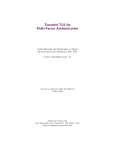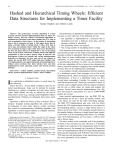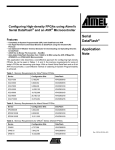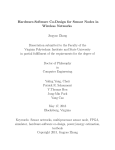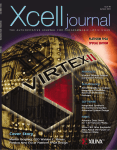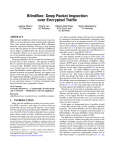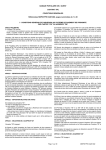Download as a PDF
Transcript
A Combined Hardware and Software Architecture for Secure Computing Jörg Platte Edwin Naroska Computer Engineering Institute University of Dortmund Germany Computer Engineering Institute University of Dortmund Germany [email protected] [email protected] ABSTRACT 1. Remote code execution becomes more and more important as can be seen by Grid computing or distributed computing projects like SETI@home. However, executing programs on foreign computers leads to security risks if the program contains sensitive data or algorithms. Current operating systems can protect user programs from other malicious programs running on the same host. But this does not prevent attacks from a system administrator or a malicious operating system. Further, even if the operating system is trusted it is possible to physically intercept communication between main memory and processor to gather information about the executed programs. As a result, these security risks prevent the execution of sensitive algorithms or programs computing on sensitive data on not trustworthy remote systems. In this paper we present a combined hardware and software architecture to provide a secure and tamper resistant computing environment without relying on trusted system administrators and a fully trusted operating system. Our proposed architecture provides a security enhancement implemented on top of a standard processor. Compared to external co-processor solutions, our architecture does not suffer from memory, functionality and performance limitations. Furthermore, normal and protected programs can be run concurrently in a multitasking environment. In near future, there will be a need for securely executing programs on foreign computers. For example, in a Grid computing environment, many different computers owned by Universities or private companies can be connected over the Internet to dynamically build a supercomputer in order to solve hard scientific problems or performing complex simulations. The Grid also becomes more and more interesting for companies if they do not have a constant workload to utilize a local simulation cluster. Then, parts of the available computing power can be rented out to foreign users. However, most algorithms and/or data are intellectual property of the foreign user and therefore special care must be taken to protect them. Furthermore, protection of algorithms and data is not sufficient because any modification of the program flow must be prevented since this may result in wrong execution results1 . Hence, our proposed architecture changes must achieve two goals: Categories and Subject Descriptors C.1 [Processor Architectures]: Miscellaneous; D.4.6 [Operating Systems]: Security and Protection General Terms Security, Design Keywords Certified execution, encrypted programs, secure processors Permission to make digital or hard copies of all or part of this work for personal or classroom use is granted without fee provided that copies are not made or distributed for profit or commercial advantage and that copies bear this notice and the full citation on the first page. To copy otherwise, to republish, to post on servers or to redistribute to lists, requires prior specific permission and/or a fee. CF’05, May 4–6, 2005, Ischia, Italy. c ACM, (2005). This is the author’s version of the work. It is posted here ° by permission of ACM for your personal use. Not for redistribution. The definitive version was published in CF’05, May 4-6, 2005, Ischia, Italy. http://doi.acm.org/10.1145/1062261.1062308. INTRODUCTION 1. Protection of program code and data. It should be impossible for an attacker to get information about the executed program code and the computed data. 2. Preventing any external modifications during program execution. The program must be executed in the intended way or aborted immediately. Unlike a dedicated co-processor to execute secure programs, we present a processor architecture which allows execution of both normal unprotected programs and encrypted protected ones. Therefore, existing programs can easily be secured without the risk of not being executable due to memory restrictions or major architecture changes, which might occur in the co-processor case. This allows simple integration into existing computers, since most software is unencrypted and can be executed without any changes. However, in this work we will not present physical modifications required to protect the core of a processor from physical access. Only logical changes to the processor design and the software will be discussed. The means to establish security include memory encryption and protection, register protection and a partly trusted operating system. All these changes provide parallel execution of trusted and normal programs at the same time. Further, trusted programs do not suffer from significant limitations. 1 We are assuming that all user programs do not contain any programming errors resulting in wrong computations. Figure 1: SPARC Register Windows LOCAL OUT Set 0 Set 0 Set 0 CWP IN IN LOCAL OUT IN Set 2 Set 2 Set 2 Set 0 OUT IN LOCAL OUT IN LOCAL OUT Set 3 Set 1 Set 1 Set 1 Set 3 Set 3 Set 3 SAVE, TRAP RESTORE, RETT In section 2 we are describing the process of loading and executing a program. The requirements for a secure execution are presented in section 3. Our proposed design is explained in section 4. Section 5 describes other approaches to provide a secure computing framework. Sections 6 and 7 are presenting our simulation results and explain future work. 2. PROCESSOR ARCHITECTURE This section provides a short overview about the SPARC architecture [9, 12], which is used as a base for our processor design. A SPARC processor provides 32 logical registers, separated into four different register subsets: global, local, in and out. Each subset contains eight registers. Internally they are mapped to up to 520 physical registers in up to 32 sets. As you can see in figure 1, the in and out registers of side by side sets are overlapping to allow parameter passing. The register mapping is controlled by the current window pointer (CWP). Executing SAVE instructions or during a TRAP the window pointer is decremented and incremented by RESTORE and RETT instructions. A CWP over- or underflow results in a TRAP which is used to read or write the current register set from or to the stack. Like most modern processors, the SPARC architecture provides a user and a supervisor mode [9]. In user mode execution of privileged operations and access to sensitive processor status registers and memory regions is prohibited. This is used to protect OS resources from modifications by user programs. To enter the supervisor mode, a TRAP instruction is executed. The SPARC architecture provides 256 TRAP’s. On each TRAP a branch into the trap table is performed. This table stores the first four instructions of every corresponding TRAP handler. At the end of the TRAP function, the OS returns to the user program by executing a RETT (return from trap) instruction. The memory management unit (MMU) allows mapping between a program dependent memory layout (context) to the physical memory available. The MMU distinguishes programs by a unique process ID (context ID) and can only be configured in supervisor mode. On a multitasking OS like Linux many programs can be executed in a time-multiplex manner using a scheduler. The scheduler grants every program a time slot in which the program can be executed. At the end of the time slot a timer generated interrupt will invoke a TRAP function to enter supervisor mode. This TRAP handler will save all related data like the stack pointer, program counter and the global and floating point registers of the current program in a process related memory area and the remaining registers on the stack. Then the OS can safely change the MMU context to the other programs memory layout and restore its register values. Finally, the OS returns to user space using the RETT instruction to continue execution of the newly selected program at the previously interrupted position. 3. REQUIREMENTS FOR SECURE COMPUTING In this chapter we want to sum up the requirements for a secure and tamper resistant execution and present appropriate hardware and software changes. In detail, the following features must be present to provide a secure environment: • Algorithm and data protection: To protect the program code and all sensitive runtime data stored on the stack or the heap, a transparent encryption of these parts must be supported. Otherwise, the memory contents may be directly read from memory after deactivating the processor or sniffed from the memory bus. • Identification of the target processor: The target processor must be identified to prevent execution on a simulated or modified processor. For example, only the target processor shall be able to execute the program code. • Data and program integrity: Encryption does not prevent manipulation of encrypted data. Hence, additional integrity checks are required to prevent the following attacks, which may result in data leakage or an unintended execution: – Program instruction manipulations – Runtime data manipulation – Replacement of newly written runtime data by old data (replay attack) • Proper TRAP handling: Interrupting a trusted program and restarting it later without the ability to modify any program related data in the meantime must be ensured. Hence, the state of the program must be fully reconstructed after the TRAP in every case without the possibility to modify program data in an unauthorized way. This leads to the following requirements during a TRAP: – Register protection: Any unauthorized read or write access to register values must be prevented since they may contain sensitive data. – Permission of authorized register access: During a TRAP some register values must be read by the OS. Examples are parameters of the system call, the program counter or the stack pointer. During a register window over- or underflow or a context switch one or all register sets must be read or written. Therefore, a mechanism to allow authorized access to all registers is required. – Prevention of program counter manipulations: Any manipulation to the program counter can be used to execute the program in the wrong order, to skip parts of the program or to crash the program. Further, vital parts of the program may be skipped. Hence, any program counter manipulation must be prevented. – Prevention of unauthorized memory access by the OS: The OS has full access to the whole memory area of the program and knows all dynamically requested memory regions and the current position of the stack pointer. Therefore, a manipulation or examination of memory areas must be prevented. However, some memory access must be allowed, since, as described above, the register values must be stored in memory during a context switch. • A partly trusted OS: As we have seen above, the OS must be able to alter protected program data during a TRAP in an authorized manner. Therefore, all parts of the OS which need access to these sensitive data must be trusted. Nevertheless we can only provide a protection against direct program or data manipulation or disclosure. The OS can return false or forged values during a software TRAP. Therefore, the user program must check all values returned by the OS. This can be done using cryptography for all external data transfers like file or network access. Additionally, newly allocated memory regions must be validated, to assure that the memory resides in a protected area of the virtual address space. These checks can be done in user space and included in appropriate library functions. • Statically linked programs: Dynamically linked programs will be linked during startup or runtime with shared libraries installed on the actual system. These libraries are unchecked and may contain malicious program code. As shared library functions are executed in the context of the program and therefore having access to all program data, malicious shared libraries may be used to reveal protected program code or data. As a result, only statically linked programs are supported by this architecture. 4. DESIGN This section describes all design issues in detail. The last section has given a rough overview about all requirements and here we want to present all changes needed to realize the secure computing requirements. At first we want to explain the hardware modifications and then the software changes. 4.1 Hardware modifications In this section we describe hardware modifications based on a SPARC RISC processor. Our goal was to carefully enhance the processor to implement the security enhancements without major changes to the processor core, the OS and the userspace program code. Therefore, we avoided direct changes to the processor where possible and implemented most additional functionalities as separate additional units. The units are controlled by a set of new instructions (see table 1). Each time, the processor detects an unauthorized access, the currently running trusted program is terminated immediately and all program related data in the processor is cleared. This ensures, that a trusted program can only be Table 1: Important new instructions Description Secure TRAP Start Secure TRAP End Copy the decrypted secret key k to the keystore Decrypt the secret key DK Set the virtual memory location of the enRH crypted root hash RPROT Set Register protection mask for the current register set RUNLOCK Permit write access to all registers Set the encrypted and protected areas AS AG Get the encrypted and protected areas TERM Terminates a secure process and delete k from the keystore Name STS STE KC Figure 2: The modified processor core Tamper resistant CPU core Register Protection Register Set AES Unit Integer Unit Status Register Keystore Cache RSA Unit MMU Unprotected Main Memory executed successfully if it is not modified. Additionally, a TRAP is generated to inform the OS, that something went wrong during execution. In the following all modifications are described in detail. Figure 2 gives an overview about the modified design. The new hardware units are marked with dotted lines. 4.1.1 Cache The cache is a functional unit which must be a physical part of the processor core to ensure data protection, since the cache stores all data unencrypted. This cache provides two additional functions compared to a normal cache. First, it can transparently encrypt and decrypt all data read from main memory. Second, the cache can verify the integrity of the read cache lines. Both functions are implemented inside the cache to improve the performance. 4.1.1.1 En-/decryption. A cache must support a random access to the main memory in cache line size quantities. This requires independent encryption and decryption of every cache line. Hence, using a cipher block chaining (CBC) mode for encryption, where each block must be XORed with the previous one, is not possible. Additionally, to simplify the design, every cache line must be aligned to 128 bit quantities, which is equal to the AES block size. We have chosen a cache line size of 512 bits or four AES blocks (called cache blocks in the following). To speed up the decryption process, each AES cache block can be decrypted independently of the other three blocks Figure 5: Hash tree layout Figure 3: Hash value computation Cache Line Cache Block Bp1 128 Bit Cache Block Bp2 128 Bit Hash block Cache Block Bp4 128 Bit Cache Block Bp3 128 Bit Cache block Root Hash XOR Hash H 128 Bit Session Key and Virtual Address (V) Secret key k 0…..0 V 128 Bit 352 Bit 32 Bit information about the hashed contents of the cache line. Figure 4: Decryption of a cache line Hash 128 Bit Memory contents XOR Bc1 Bc2 Bc3 Bc4 R1 R2 R3 R4 128 Bit 128 Bit 128 Bit 128 Bit 128 Bit 128 Bit 128 Bit 128 Bit Fetch Fetch Fetch Fetch AESk AESk AESk AESk XOR XOR Cache Block Bp1 128 Bit Cache Block Bp2 128 Bit XOR XOR Cache Line Cache Block Bp3 128 Bit Cache Block Bp4 128 Bit and the decrypted data can be passed immediately to the processor. However, the integrity of a cache line can only be checked after reading all four blocks. We are using AES with the secret key k (Ek ) in counter mode. In counter mode, a so called counter value is encrypted and XORed with the plaintext data for encryption. Typically, the counter value is a value which will be increased for each new encryption. In our case, we are using the AES hash [1] function2 H to compute a cache line dependant hash value as a base counter. Other secure hash algorithms like MD5 [10] can be used, too, but we have chosen AES because our design already contains an AES encryption unit. Figure 3 describes the hash value computation. The hash value is used to check the integrity of the cache line and to provide a unique counter value. At first, all four plaintext cache blocks Bp1···4 are XORed with k and the virtual base address V of the cache line: • Incorporating the base address V of the cache line is required, because otherwise, the encrypted cache line may be copied to another virtual address without detection. Further, the same contents at different addresses are encrypted differently. • XORing the secret key k into the plaintext is required to make the hash value computation dependant on k. Otherwise, the hash value may be exploited to extract 2 Unlike the proposed size of 256 bits, we are using only a key and block size of 128 bits resulting in a 128 bit hash value. The result is then fed to the AES hash function H to compute the hash. As you can see in figure 4, every cache line consists of four cache blocks. Hence, one hash value is not sufficient as a counter, because this would result in the same pattern used for four cache blocks. Therefore, the hash value is XORed with the four different 128 bit patterns R1···4 to generate four different counter values. The most time consuming parts, the encryption Ek of the counter value and the memory fetch, are parallelized to hide the encryption latency. When both the data and the encrypted counter values are available, they must only be XORed to get the decrypted data. Encryption of a plain cache block Bpx and decryption of a ciphered cache block Bcx are working exactly the same as in both cases the counter value is only encrypted. As a result, a ciphered cache block will be computed as follows: Bci = Ek (H(Bp1 ⊕ k|Bp2 |Bp3 |Bp4 ⊕ V ) ⊕ Ri ) ⊕ Bpi for i = 1, 2, 3, 4, where | denotes a concatenation 4.1.1.2 Data integrity using hash trees. Data integrity cannot be ensured using the modified hash approach described above, because it cannot prevent replay attacks. Therefore, we have implemented the hash tree model described in [4]. In this model, all hash values are stored in a separate virtual memory area. Since a hash value consists of 128 bit and a cache line is 512 bits long, we can store up to four hash values in a cache line. As you can see in figure 5, each hash line (=a cache line storing only hash values) must be protected by another hash value. At the end the last four hash lines are protected by a root hash. This root hash must be stored permanently in the processor using the RH instruction at the beginning of the program execution to prevent further manipulations. Therefore, only the processor can transparently update all hash values including the root hash based on data changes in the protected memory. To prevent manipulations of the executable, only the root hash must be stored encrypted in the executable. All other hash values for static data are stored unencrypted. This concept provides maximum security and reduces the number of hash comparisons, since already checked hash lines in the cache are always trustworthy and hash line comparisons must only be taken up to the first verified hash line found in the cache. Hash values of currently unused memory areas are set to zero. This reduces the size of the executable dramatically, since only used hash values must be saved. The OS can transparently map pages filled with zeros to the unused parts. The current context ID in conjunction with the trust level of the currently executed instruction changes the way data can be accessed. Data decryption is only performed for trusted program code executed with the correct context ID. In every other case, the encrypted data is passed to the processor. Already decrypted cache blocks are invalidated to encrypt them and reread them encrypted, if an untrusted instruction tries to access them. If encrypted parts are modified by untrusted instructions, the corresponding hash values are not updated. This results in an immediate process termination, if the trusted process accesses them. Operating System Hash Tree DMA Parameter passing 00000000 RSA Unit The RSA Unit is required to proof the origin of the processor by encrypting the secret key k of the secure program to be executed with the processors public key kpub . The integrity of kpub can be checked by comparing it with the manufacturer-signed key of the target processor. This guarantees successful decryption only by the selected processor, because the corresponding private key kpriv is stored in the RSA unit and cannot be read by a program. The decrypted secret key k must then be stored in the internal keystore by using the KC instruction. Therefore, it is impossible for the OS to read k in cleartext. 4.1.3 Executable Register protection Register protection is a major part of this security architecture. In our design the current context ID is stored with every written register value. Every read or write access to a protected register by an untrusted instruction terminates the currently running program. Likewise, a read access to a register not written by the currently running protected program terminates the protected program. To allow parameter passing between the OS and the program, register protection can be partly deactivated using the RPROT instruction. It is executed in a trusted environment and allows to set a mask to unprotect matching registers in the current register window. Already protected registers cannot be unlocked using RPROT, because protection is only disabled for the next register write access, but unlocked registers can be read without program termination. Any change of the the register window pointer deletes the mask set by RPROT. However, some OS TRAP routines must have access to all register values. For example, during a context switch, all register contents must be stored on the stack by the OS. Ad- Unprotected Area 4.1.2 Protected Heap Encrypted Area Memory requirements. Due to the hash values used to decrypt and verify the memory contents memory demands are increased. The first level of hash lines (the hash values printed on top of the cache blocks in figure 5) consumes additional 25 % memory of the original memory size. These hash values are required both for the program code and volatile encrypted data. The other levels up to the root hash are only required to protect volatile data, because replay attacks are only possible on this kind of data. Programs which generate instructions on the fly can be used with this design, too, but then replay attacks may be possible. This can be avoided by using a modified design which provides a special area for static program code. All other program code can then be verified using the complete hash tree. The additional overall memory penalty for the hash values can therefore vary between 25 % (only static program code) and 33 % (only volatile data). Protected Area Protected Stack Unprotected Area 4.1.1.3 Figure 6: Memory Layout FFFFFFFF ditionally, during a register window over- or underflow, some register values must be saved or restored. Our architecture permits full access, if the corresponding TRAP instructions accessing them are trusted. This results in TRAP’s which must be executed in an fully trusted environment. Additionally, another instruction for permitting write access to protected registers is needed, since during a context switch the register values must be overwritten with the values of the new context. 4.1.4 Speculative execution Checking the data integrity is a very time consuming task. Hence, it is desirable to execute most instructions speculatively while checking. This improves the performance, but leads to problems, if the instructions are tampered, since execution of this kind of instructions must be prevented. The processor will terminate an already running program immediately after detecting a tampering attempt. Therefore, instructions can be executed speculatively until a TRAP is executed. In case of a TRAP, the processor waits until all read data are checked and then starts executing the TRAP. Hence, modified instructions or data are detected at least before the next system call or context switch is executed. 4.1.5 Memory layout The cache must be able to distinguish between normal, protected and encrypted memory. In our design we are using a relatively fixed layout to simplify hardware implementation. Figure 6 shows a valid per process memory layout for a linux system. To execute protected programs, at least four different and partly overlapping virtual memory areas must be provided. The biggest area is used for protected data and each cache line in this area is protected by a hash value. The trusted part of the OS must be in the upper part of this area. Inside this area a second area of encrypted memory can be specified. Each read or write access in this area leads to a transparent de- or encryption and an update of the corresponding hash entries. This area is dedicated for the program code, stack and the heap. The remaining parts of the memory, including the hash values are unencrypted and unprotected and can therefore be used for DMA access, parameter passing (between the OS and the program) and shared memory. The memory layout must be passed to the cache using the AS instruction and cannot be modified during runtime of the whole program. 4.1.6 Virtual memory The cache must operate on virtual addresses, as they are needed for encryption decryption and for the hash line address calculation. This results in an additional data path between the cache and the MMU to query virtual addresses. To speed this up, the cache can store physical and virtual addresses for each cache line. Then, the cache can compute the required hash line address internally and if the computed hash line is in the cache, no MMU query is needed. Virtual memory provides the ability to move currently unused parts of a program on the hard disk and reread this memory on demand. Because of this, the operating system must ensure the availability of all required hash values in physical memory. For example, if one page containing hash values is not found, the cache cannot continue checking the integrity or writing dirty protected blocks back to memory. As a solution, we are disallowing removal of pages containing hash values required to check other hash values or cache blocks still located in physical memory. They can only be removed, if the corresponding memory regions protected by these hash values are also removed. 4.2 Software changes Due to the new instructions, the cryptography units and the memory layout, software modifications in the OS and the executed program are required. At first, we will describe the required modifications in the OS and then the changes to the executable. 4.2.1 Operating System changes The first major change in the OS is required due to the new memory layout. 4.2.1.1 Memory Layout. A small trusted part of the OS is located in protected memory. These instructions must remain static during the whole runtime of the OS, because every trusted program must provide matching hash values. This memory area is used to store TRAP table and parts of the TRAP routines. The virtual memory management of the OS must be adjusted to consider the hash tree layout. During a page fault not only the page with the requested data but also all pages needed to validate this cache line must be loaded. This increases the latency, before the interrupted program can be restarted. Furthermore, pages containing hash values cannot be swapped to disk, while the memory regions protected by these pages are still in memory. 4.2.1.2 TRAP’s. The TRAP table and the first and last parts of the TRAP routines must provide additional instructions to guarantee unmodified execution of a program. At the beginning of every TRAP, which may execute unprotected instructions, the current TRAP number and the frame pointer is stored at a special protected memory area unique for every program. Then, the normal unprotected TRAP routines can be executed after executing the special instruction STE. It ends the protected part of the TRAP routine. As a RETT instruction of an encrypted program can only be executed from trusted memory, every TRAP must jump to the corresponding end of its TRAP routine located in this trusted memory area. There, the secure TRAP mode must be reenabled using the special instruction STS. Then, the previously stored TRAP number and the previously stored frame pointer can be compared with the current ones and on a match the OS can safely return to the program. Storing of the frame pointer ensures, that the current register set is valid. An invalid register set cannot be detected by register protection, if the registers in the wrong set are written by the trusted program, but in another recursion level. But if the stored stack pointer matches the one in the current register set and the register value can be read, the current register set is valid. The STE and STS instructions are required to ensure the whole execution of the last part of the TRAP routine. Otherwise, a malicious OS may jump directly to the RETT instruction without checking the TRAP number and the frame pointer. In our design this is impossible, because the RETT instruction can only be executed in TRAP mode which can only be re-enabled by the STS instruction. The OS must be able to execute trusted and normal programs simultaneously. The additional checks during a TRAP are useless for normal programs. As a result, the OS should provide two TRAP tables. One for normal and one for protected programs. The SPARC architecture supports this with a TRAP-table base register. This register must be updated during a context switch to reflect the type of the program to run. 4.2.1.3 Program loader. The program loader must be enhanced to detect protected programs and start them in a protected environment. The largest part of the program loader is located in unprotected memory, because it must operate before any program providing hash values is loaded. After detecting an encrypted program, the encrypted secret key k must be read and passed to the RSA unit for decryption. In the meantime, the OS maps the program parts (the program code, hash values, data) to their destination in the virtual memory address space. Then, the memory layout must be passed to the cache using the AS -instruction. This instruction can only be used before k has been stored in the keystore to prevent subsequent manipulations by modifying the protected areas during runtime. After decrypting k, the OS can pass it to the cache using the KC instruction. Then, the position of the root hash is passed to the cache using the RH instruction. For simplicity, it is stored in a separate encrypted cache line to allow the cache to decrypt it using the standard decryption hardware. The root hash is then permanently stored in the cache and the program loader exits and starts the actual program. 4.2.2 Program changes The architecture requires small user space changes. Fortunately, most of them can be be implemented by modifying low level libraries and therefore they are mostly invisible to programmers. For example, the libc must be modified to un-protect registers before a system call using the RPROT instruction and memory regions containing parameters must be allocated in unprotected memory parts (see figure 6). At startup, a protected program must check the memory regions for protected and encrypted memory. They are set at program startup by the program loader using the special instruction AG. During runtime, the regions cannot be modified, but the program loader may initialize them wrongly. Therefore, the secure program checks them. Unfortunately, the OS may return arbitrary addresses for a malloc call and therefore, each returned virtual address must be verified. Otherwise, the OS may return memory in unencrypted regions. Fortunately, this check can be transparently done in the libc, too. The only major change from the programmers point of view is the handling of dynamically requested memory. Now, the programmer may request either encrypted, protected or unprotected memory which results in an extended system call to specify the memory type. The default memory type is encrypted/protected memory. Hence, only programs or libraries requesting memory for parameter passing to the OS must be changed to explicitly request unprotected memory. All other libraries can remain unchanged. As a result, a wide range of programs can be compiled for our architecture without, or only with slightly changes in the memory handling. This significantly simplifies program development. 4.2.2.1 Compiler changes. A modified instruction set require changes in the compiler suite. Fortunately, all new instructions are used in low level parts of the OS and the libraries, which are mostly written in assembler. Hence, only the assembler part must be enhanced to support these instructions. Other parts, like the encryption and the computation of the hash values, must be done after statically linking the program. They can be implemented using a postprocessor and require no modifications to the existing toolchain. 5. RELATED WORK Using cryptography to protect algorithms and data in a tamper resistant environment is not a new approach. Secure co-processors have been proposed which provide a tampersensing and tamper responding secure environment. These processors can be implemented on smart cards (for example, [7]) or as a co-processor shown by [14] in a PC (for example, the IBM 4758 [2]). These co-processors provide a secure environment. But they are limited in terms of processor speed and memory and often, programs must be significantly modified to be suitable to this kind of co-processors. Therefore, they do not provide an easy to use and expandable secure environment. A more related approach to ensure a secure execution of programs are the eXecute Only Memory (XOM) architecture [6] and its successor, the AEGIS [11] architecture. Both architectures provide transparent program and memory encryption using an enhanced standard processor. Protected parts begin with a special instruction and all further instructions are encrypted. Unfortunately, only small parts of a program can be encrypted, because both architectures do not allow system calls while in encrypted mode. Only normal interrupts are allowed and the processors hardware ensures register and program counter protection by saving them in encrypted memory and clearing all register contents. This prevents any parameter passing to the operating system and allows process restarting only at the interrupted position. Further, this design also complicates the encryption of large algorithms, because many parts of an algorithm typically rely on additional library functions and these library functions must be split into secure parts and parts requiring system calls, for example by calling malloc functions. Hence, all libraries, not only low level ones, must be revised and modified. As a result, protected algorithms can only easily implemented for small algorithms. In contrast to the AEGIS design, our design can protect the whole program including additional libraries. The AEGIS architecture provides status changes during an interrupt and guarantees correct restauration. But an AEGIS program contains unprotected parts used for system calls. During execution of this parts, a malicious OS can alter the program counter or modify register values and therefore, the unmodified execution of a whole program with encrypted and unencrypted parts cannot be guaranteed. As a result, only sensitive algorithms can be protected, but not the whole program. In AEGIS, memory protection is done by encrypting the memory contents with AES [8] and protecting them by hash values. Like our approach, both encrypted and normal programs can be executed in a multitasking environment. But encryption is done by encrypting the data directly. This increases the decryption latency, because the data must first be read and can then be decrypted. In our design, encryption and fetching data can be done simultaneously and the fetched data must only be XORed with the encrypted hash value. As we can see in section 6, this hides the decryption latency very effectively. On the other hand, writing encrypted data is slower in our case, since the hash value must be computed first. The AEGIS architecture can start encrypting the data directly after selecting a random initialization vector. But fortunately, this additional latency caused by our architecture can be hidden by providing a longer write queue. For most programs the read latency is more important, since a program can only be continued after providing the requested data. Another advantage of our design is is the amount of memory required to encrypt and validate the memory. We must only store the counter value, which can be used as a hash value to validate the integrity of the cache line and as a counter value to decrypt the cache line. Therefore, only one additional read access is required to encrypt and check the contents of a cache block. In the AEGIS architecture the hash and an initialization vector must be stored. AEGIS provides register protection in hardware by storing all registers in encrypted memory and clearing the registers during an interrupt. In a multitasking system our approach is much faster, particularly with a huge register set. Register values are protected, too, but are stored in memory only on demand during a context switch or a register window overor underflow. For example, a short TRAP, which needs only the current register set, does not result in storing all registers in memory. Other approaches to provide a trusted environment, like TCPA [13] can provide only a trusted software platform. Hardware attacks, like sniffing on busses, are still possible. Additionally, compared to our design larger parts of the operating system must be trusted which increases the possibility of exploitable errors in these parts. Therefore, mostly software based systems do not provide the same protection level as our architecture. 6. SIMULATION RESULTS Table 2: Size of the new hardware units Slices LUT Part LEON2 (unmodified) 3837 6972 10016 LEON2 (modified, without RSA 7073 and AES units and cache) AES unit 823 5207 RSA unit 14562 26533 Currently, we have implemented and tested parts of the architecture in hardware and software. The basis of our hardware modifications is the LEON processor [3], a freely available SPARC compatible VHDL model. LEON provides a fully featured SPARC V8 processor including a 5-stage integer unit, L1 cache, MMU and memory interface. We have synthesized the VHDL code for a Virtex II XC2V4000 FPGA to measure the size requirements of the changes. Our modifications are mostly implemented in external units to simplify the design process. Hence, we did not modify the original L1 cache, but we added an additional L2 cache which implements all the encryption and decryption parts. The MMU was modified to pass the physical and virtual address along with every data access to the L2 cache. The usage of a L2 cache with an unmodified L1 cache requires to flush the L1 cache at every TRAP, since the L1 cache provides no extended access control. We have implemented the new instructions in an additional pipeline stage in the MMU to have direct access to the L2 cache. The cache has direct access to a AES encryption unit. Due to the usage of the AES counter mode, we do not need a decryption unit, since the counter value is encrypted only in every case. This simplifies the design of the AES unit and saves space. We are currently using eight single AES units3 in total to speed up encryption of the four counter values for each cache line. By using AES in counter mode, the decryption latency can be fully hidden compared to the AEGIS [11] implementation, where the cache block contents are directly encrypted. In [5] an AES counter mode hardware design is presented, which has an encryption latency less than the transmission latency for 512 bits of a typical DDR400 SDRAM module. Therefore, with this AES module, the data can be decrypted on the fly without further delay after reading the whole cache line. The only additional delay is caused by reading the corresponding hash value for the cache line. The LEON core implements 136 registers in 8 sets. In our architecture, for each register value the current 8 bit context ID is stored. This ID is evaluated internally and cannot be 3 four for read access and four for write access read or written by software. This consumes 1088 bits extra register memory. However, it can be reduced by limiting the number of simultaneous encrypted processes and assigning only lower ID’s to protected programs. The RSA unit is implemented as a separate part of the processor with its own clock signal and programmed by a separate interrupt driven interface. This makes this unit independent from the other design regarding to the main clock and timing constraints, because it typically operates at slow clock rates compared to the rest of the processor. This does not affect the performance of the whole processor significantly, since this unit is only needed during the start of a program and the processor can execute other instructions during RSA decryption. As we can see in table 2, the RSA unit needs more than two times more slices than the modified LEON core. This is due to the LEON2 design, which was chosen to provide a small processor implementation without additional complex units like branch prediction, speculative execution or dynamic scheduling. The cache will consume the largest part of the processor design, as it must be as large as possible to speed up decryption and integrity checks. As a result, the logical changes to the processor design, like register protection, new instructions and speculative execution of protected instructions, are small compared to the required additional cryptography units. 7. CONCLUSION AND FUTURE WORK In this paper we presented an architecture, which permits concurrent execution of unprotected as well as protected/encrypted programs on the same processor. Our architecture can protect programs from program code and data manipulations and program flow manipulations. Data is encrypted using AES in counter mode with a 128 bit key. The counter value is additionally used as a hash value to detect all external modifications. This saves memory and requires only one additional memory access to decrypt a cache line. To prevent replay attacks, all counter values except those values used for static program code, are additionally protected by hash values resulting in a hash tree. In our design, integrity checks and data decryption are transparently implemented in the cache. Besides memory encryption, the register set must be protected, too. Our architecture implements a register protection, which grants access to register values only for trusted instructions. Unauthorized register access is treated like a manipulation attempt and results, like any other detected manipulation, in the immediate termination of the protected program. One design goal was to allow system calls for protected programs in order to to minimize the required changes from a programmers point of view. Therefore, parts of the operating system must be trusted to allow parameter passing in registers or memory. We tried to minimize the trusted parts of the OS by requiring trust only for low level parts in the TRAP handling. All other parts of the OS can remain untrusted. Each protected program establishes trust to these parts of the OS by providing matching hash values for these parts. These combination of extended hardware protection in conjunction with the trusted parts of the OS can prevent all manipulations by external attackers (like manipulations in external memory). Internal attacks by the administra- tor or the OS are prevented, too, because modifications in trusted parts and access to protected memory regions or registers by untrusted parts will be detected and prevented by the hardware. All protected programs can be written without major changes compared to unprotected programs and all program code and volatile data is protected by default. Most of the required user space changes can be implemented transparently in low level libraries. Therefore, only minor changes in the compiler suite are required. As far as we know this is the first architecture that provides an integrated secure environment, which can protect a program during the whole execution. This is achieved by preventing data, instruction and program flow manipulations with additional encryption. As a result, the intellectual property of algorithms and data is protected. Unlike secure co-processors, our design can easily be enhanced in terms of memory and processing power like any other unprotected design. Compared to the AEGIS design, our architecture provides a faster memory decryption and less memory overhead for the hash values. Additionally, with our system the whole program can be encrypted by providing system calls for secure programs and not only small parts of the program. This significantly simplifies secure program creation. Since our design requires changes in the operating system, full tests with modified hardware and a modifies OS are required to get an overview about the additional latencies triggered by our design. This will be done in the future. 8. REFERENCES [1] B. Cohen. AES-hash. http://csrc.nist.gov/CryptoToolkit/modes/proposedmodes/aes-hash/aeshash.pdf, May 2001. [2] I. Cryptographic Products. IBM PCI Cryptographic Coprocessor: General Information Manual, May 2002. [3] J. Gaisler. LEON2 Processor User’s Manual - XST Edition (Version 1.0.24). Gaisler Research, http://www.gaisler.com/doc/leon2-1.0.24-xst.pdf, 2003. [4] B. Gassend, D. Clarke, G. E. Suh, M. van Dijk, and S. Devadas. Caches and Hash Trees for Efficient Memory Integrity Verification. In Proceedings of the Ninth International Symposium on High Performance Computer Architecture (HPCA-9), Feburary 2003. [5] A. Hodjat and I. Verbauwhede. Speed-area trade-off for 10 to 100 Gbits/s throughput AES processor. In 2003 IEEE Asilomar Conference on Signals, Systems, and Computers, November 2003. [6] D. Lie, C. A. Thekkath, M. Mitchell, P. Lincoln, D. Boneh, J. C. Mitchell, and M. Horowitz. Architectural support for copy and tamper resistant software, 2000. [7] S. Microsystems. Java card security white paper. http://java.sun.com/products/javacard/JavaCardSecurityWhitePaper.pdf, October 2001. [8] NIST. Specification for the Advanced Encryption Standard (AES) - Federal Information Processing Standards Publication 197. National Institute of Standards and Technology, http://csrc.nist.gov/publications/fips/fips197/fips197.pdf, 2001. [9] R. P. Paul. SPARC Architecture Assemply Language Programming, & C. Prentice-Hall, Inc, 1994. [10] R. Rivest. RFC 1321: The MD5 message-digest algorithm, Apr. 1992. Status: INFORMATIONAL. [11] G. E. Suh, D. Clarke, B. Gassend, M. van Dijk, and S. Devadas. AEGIS: architecture for tamper-evident and tamper-resistant processing. In Proceedings of the 17th annual international conference on Supercomputing, pages 160–171. ACM Press, 2003. [12] SUN. The SPARC Architecture Manual, version 8. SUN Microsystems, http://www.sparc.com, 1992. [13] TCG. Trusted computing group. http://www.trustedcomputing.org. [14] B. Yee. Using secure coprocessors. PhD thesis, Carnegie Mellon University, May 1994.












